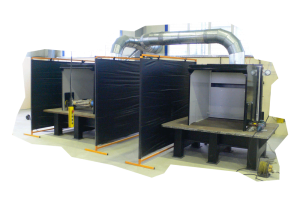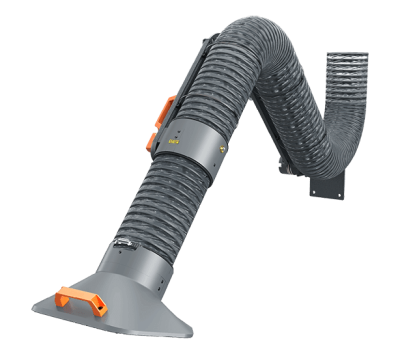Full Description
Dust from woodworking activities, for example, joinery, sawmills and timber should not be overlooked in the workplace. Various kinds of wood materials, matched with different treatment coatings make dusts an unpredictable and dangerous hazard in the workplace. Therefore, it's essential to implement effective woodworking dust extraction solutions.
From an operational perspective, it makes good business and logistical sense to maintain, or keep on top of dust in the workplace with the use of a local exhaust ventilation (LEV) woodworking dust extraction system. This is because it can save workers’ time cleaning up, but also there will be fewer slips and trip hazards caused by dust that’s settled. Also, dust produced from wood-related activities is flammable and has the potential to cause a serious fire or, albeit very rare, the potential to cause an explosion.
GET IN TOUCH
Use Dust Extraction To Reduce Exposure in Woodworking
Different kinds of wood can contain various types of bacteria, fungi and moss spores. The volume of dust generated can depend on the cutting method and the type of wood being used. Some factors to consider include whether the timber is green or seasoned, whether it is a hardwood, softwood, or composite board, and how aggressive the machine cutter or blade profile is.
Fine dust poses the most significant risk to human health, as it can penetrate deeply into the lungs, even through the alveoli, and into the bloodstream. The finer the dust, the more dust particles there are to suspend in the air, meaning they can be more easily inhaled.
According to the HSE's WIS3: Wood Dust – Controlling the risks guidance, this type of dust is classified as a substance hazardous to health, and exposure to it can potentially cause irreversible health problems, including:
- Irritation of the skin (dermatitis)
- Obstruction in the nose and rhinitis
- Lung diseases, such as occupational asthma
- Hardwood dust can also cause a rare form of nasal cancer
Therefore, it's highly recommended to use a woodworking extraction system to reduce the risk of harmful wood dust.
Occupational Asthma
Click the following links to find the HSE’s relevant documents for ‘G402: Health Surveillance for Occupational Asthma and G403: Health Surveillance for Occupational Dermatitis.
CONTACT OUR SPECIALISTS
Woodworking Dust Extraction Solutions
Our range of engineering control solutions is ideal for improving your workplace's air quality. By providing an LEV system, you also provide clean air for your workforce. Wood dust extraction systems typically include four core elements, which are:
- Capture hood
- Air cleaner
- Air mover
- Discharge
The capture hood should be placed as close to the wood cutting, planing or sanding processes as possible to draw away and capture dust at source before it's able to dissipate into the broader workplace. Depending on your business's production processes, a filtration system is likely to be required. An air filtration system will help capture dust produced during the cutting, planing, or sanding processes.
We offer a wide range of engineering solutions to help control and reduce exposure to dust that's produced in the working environment. We have a variety of solutions, which include bandsaw, circular bench saws, cross-cut saws, vertical spindle moulders, overhead and CNC routers, handheld sanding machines, wall saw, surface planer, fixed sanding machines (narrow belt), fixed sanding machine (disc), fixed sanding machines (drum/bobbin), chop saw and; suction hose attachment for cleaning.
Some of the woodworking dust extraction solutions we can offer, but are not limited to, include:
- Direct connections: Can be in the form of hose connections to built-in spigots on the machines themselves or via bespoke guards, hoods, etc., fabricated to suit each machine, ensuring that the dust is captured. Dust is then conveyed to a centralised filtration unit to remove captured particles and return the cleaned air to the atmosphere.
- Fine dust filters: Suitable for the extraction of various kinds of fume and dust, and are suitable for use in a wide range of applications.
- Coarse dust filters: Designed for the most challenging applications, where there is a demand for large air volume and filtration capacities. Coarse dust filter units are suitable for handling various kinds of dust types and offer extremely efficient dust filtration or dust collection capabilities to deliver reliable, continuous operation.
- Portable dust filters: A versatile product available in a choice of finishes (depending on the application), diameters, lengths and accessories. They are a very popular product in our range as they provide at-source extraction and remove pollutants from the workplace before they have the opportunity to dissipate.
VIEW FULL SOLUTIONS
Where Can You Find Wood Dust?
Wood dust forms during various woodworking processes, from sawing to sanding, and this is a hazard that can be encountered both indoors and outdoors. The dangers of inhaling wood dust persist even in an outdoor environment, although the risk is significantly reduced. Our wood dust extraction solutions are suitable for internal and external use. The core products include direct connections, filter units, and portable dust filters. Get in touch today to learn more about the woodworking dust extraction solution that's most suitable for your business.
HSE Inspections to Target Woodworking Businesses
The Health & Safety Executive (HSE) has announced that from April 2022, it will target woodworking businesses with an extensive campaign. As part of the campaign, HSE inspectors will visit businesses across the country, ranging from sawmills to carpenters. The HSE notes that in 2021, there were 12,000 deaths from lung diseases recorded, all of whom were previously exposed to wood dust at work. The campaign aims to 'help businesses whose workers cut and shape wood to take action now to protect their workers' respiratory health'. The inspectors will ensure that measures are in place to comply with health & safety guidance and to protect employees from respiratory diseases, most notably occupational asthma and nasal cancer.
The HSE recommends that woodworking businesses control exposure to wood dust by using extraction solutions that capture harmful dust at source. Inspectors will ensure that dust extraction systems for woodwork are in place and that employees understand the risks and how to operate machinery safely and correctly. They will also be looking into whether guards are fitted to protect fingers and hands, and are well-adjusted to ensure dust capture remains effective. This campaign will ensure that employers and their workers are aware of the risks associated with wood dust and why certain measures are necessary to safeguard their health.
The woodworking industry remains a key focus for the HSE, as shown by their latest update in June 2023. This update states that inspectors will continue to look for evidence throughout 2023/24. In particular, they will determine whether employers have implemented measures to reduce exposure to wood dust, whether workers understand the associated risks, and whether effective measures have been implemented to mitigate these risks. During the previous period, inspectors visited more than 1,000 sites and found that an alarming 78% of businesses were non-compliant, resulting in 402 enforcement actions. The main areas of concern included housekeeping (e.g., dry sweeping of dust), LEV maintenance and examination, selection of and face-fit testing for RPE, and health surveillance for exposure.
Given this announcement, it has never been more critical to ensure your woodworking business complies with health & safety regulations. Contact us today to learn more about our wood dust extraction systems and associated services, including LEV testing.
BOOK AN ASSESSMENT
Examples of Punishments for Woodworking Businesses
The woodworking industry is one of the most high-risk sectors for workplace accidents due to exposure to dust and fumes. Therefore, the Health & Safety Executive is extremely strict when enforcing the Health and Safety at Work Act. Businesses and personnel can expect hefty punishments if they breach health and safety regulations. Consequences include fines, disqualification from running a company, and even imprisonment. This section will discuss some of the most notable examples of real-life incidents that have resulted in severe punishment.
As part of their routine inspection of premises, an HSE inspector visited a furniture factory in Port Talbot, Wales, in 2015, during which they noticed a series of failings. The inspector identified poor control of wood dust and inadequate maintenance of equipment. They also reported noisy conditions and inadequate toilet and washing facilities. The factory was initially served with several improvement notices, allowing them to correct their faults within a specified timeframe. The HSE saw little progress following the notices and decided to take further action. The presiding judge described the accused as engaging in "nothing short of a time bomb in relation to the health and safety of employees." The director and three managers/shareholders of the company were each given a 10-month suspended prison sentence and fined £2,500. They were also disqualified from being a company director for at least five years.
In April 2023, a London-based joinery business was fined £20,000 for breaching the regulations and ordered to pay costs of £1,500. As part of the targeted campaign discussed above, HSE inspectors visited the company in May of the previous year. The inspectors discovered several failures to control wood dust exposure, such as "excessive levels of settled dust around the site." Despite having woodworking LEV extraction systems, they were disconnected and not in use. The firm had previously received two separate enforcement notices.
A recent example of a business being penalised for wood dust failures involves a furniture supplier in Northampton. According to the HSE, inspectors visited the premises and found that workers were exposed to excessive levels of wood dust. The inspectors observed deposits of dust in the sawmill and around several woodworking machines, and also noted workers dry-sweeping the dust as an inefficient and unsafe method of removal. Inspectors visited the site four times over a six-year period and issued advice and enforcement, but the company still failed to meet the requirements. Although they had a woodworking dust extraction system, it was deemed inadequate and failed to capture the dust effectively. The business was fined £14,700 and ordered to pay £4,869.46 in costs. Furniture manufacturers and suppliers are prime examples of businesses in the woodworking industry that must implement adequate solutions to keep their staff safe.
The Common Dangers of Woodworking
Woodworking is an important industry that can be a rewarding and fun experience to work in, but there's no doubt that it's also a sector that comes with unique hazards. Some common dangers of woodworking include poor hygiene, such as failing to wash hands thoroughly after coming into contact with harmful substances, as well as the risk of fires or explosions. Other risks include the use of complex machinery and dangerous equipment, such as chainsaws and power tools. As with several different industries, common accidents also involve working at heights, slips and trips, and exposure to loud noises.
At Auto Extract Systems, we are primarily concerned with harmful airborne contaminants, such as dust. Wood dust is extremely dangerous as it can create severe health problems like skin irritation, lung disease and asthma. The type of wood can also influence the level of risk to which people are exposed. Hardwood dust, for instance, is particularly dangerous as it can lead to a rare form of nasal cancer. Dust is more dangerous when the particles are finer, as this makes it far easier to inhale. In addition to the apparent risks of inhaling dust or skin contact, wood dust can also lead to more slips and trips. As a flammable substance, it can create fire hazards. Any chemicals used with wood materials, such as paints and adhesives, also pose additional health risks.
What PPE Should Staff Wear?
A woodworking dust extraction system is the most effective way to prevent exposure to wood dust; however, several other health risks are associated with employees working in this industry. The woodworking sector can be a dangerous industry, so measures should be taken to prevent accidents and serious injuries. When working with wood, staff should wear personal protective equipment (PPE) at all times. PPE is designed to protect people against hazardous situations, such as working with harmful particulates and dangerous equipment.
The number one PPE for woodworkers to wear is safety glasses or face shields. These glasses or shields will protect the eyes from projectiles such as dust and vapour, which can severely damage the eyes. Workers are also recommended to wear safety gloves. Gloves will protect staff from a range of hand injuries, including splinters and cuts. Certain equipment may be safer when used without gloves, so be sure to check the manual beforehand. Face masks or respirators can provide further protection against airborne contaminants. Other recommended PPE include hearing protection and steel-tip boots.
We Have Woodworking Dust Extraction Solutions For...
- Timber merchants
- Saw mills
- Joineries
- Furniture manufacturers
- Sawmilling and planing of wood
- Manufacturers of veneer sheets and wood-based panels
- Manufacturers of assembled parquet floors
- Other builders' carpentry and joinery manufacturers
- Manufacturers of wooden containers
- Manufacturers of articles of cork, straw and plaiting materials











































































































